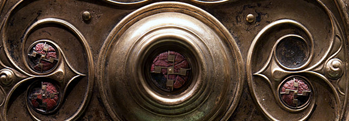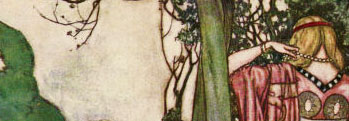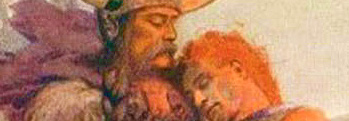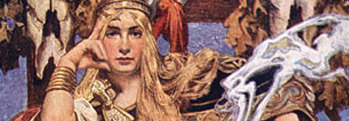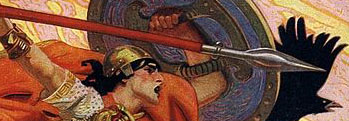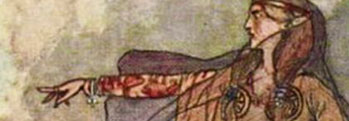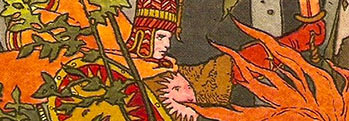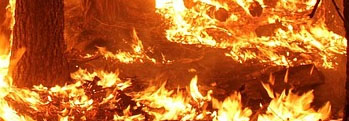Blathine Lady of the Sidhe
Irish and Celtic myths and legends, Irish folklore and Irish fairy tales from the Ulster Cycle
More dangerous than a poison dart is the bewitching love of a fairy!
 Bláthíne, whose name means “little flower” in Irish, was one of the ladies of the Tuatha Dé Danann, that mystical race of warlocks whose hardened red-gold bronze had shimmered in the sunshine when they ruled Ireland. Her beauty was famed throughout this world and the otherworld, but her story is a warning to all who would be tempted by a kiss from the people of the mounds.
Bláthíne, whose name means “little flower” in Irish, was one of the ladies of the Tuatha Dé Danann, that mystical race of warlocks whose hardened red-gold bronze had shimmered in the sunshine when they ruled Ireland. Her beauty was famed throughout this world and the otherworld, but her story is a warning to all who would be tempted by a kiss from the people of the mounds.
Bláthíne lived with her father, whose name was Mend, on the strange magical island of Inis Fir Fálgae, which some have considered to be the Isle of Man. The men of this island were fierce giants, with red or black hair so long it reached all the way to their ankles, but that didn’t deter Cú Chulainn and his friend, the powerful sorcerer Cú Roí mac Dáire, from planning to raid it and steal all of its treasures!
For they had heard of the many strange magical artifacts which Mend kept in his court, wonders of ancient science and wizardry such as the Dagda’s cauldron of plenty, which could feed the whole world. And from this we know that the island was a place half in dream, in the way of the otherworld.
By cunning, by arcane rituals, skill and unrelenting bladework the two heroes passed through many-coloured mists and across waves that looked like meadows, beyond veils of singing spirits and deadly shadows, until they at last landed on the shores of Inis Fir Fálgae. And sure enough when they departed they had more than they arrived with, and indeed, more than they bargained for!
They returned to Eriú with the three treasures of the Fálgae – namely, three red-eared milk-abounding cows who each produced the milk of ten cows every day, with three cranes called the three men of Ochain upon their backs, the great cauldron rich in gold and silver from which a hundred men could come away satisfied, and Bláthíne daughter of Mend.
There was a cauldron in the fort:
The calf of the three cows,
Thirty cows within its gullet,
That was its portion.
They used to go to that cauldron,
Delightful was the struggle,
Nor did they come away from it again
Until they left it full.
There was much gold and silver it,
It was a goodly find.
I carried off that cauldron
With the daughter of the king.
No sooner had they returned than Cú Roí and Cú Chulainn fell to arguing over their loot, for they had both fallen in love with the gentle Sidhe princess on their return journey. Cú Roí said she was his spoil, for it was he who had taken her, but Cú Chulainn would have none of it. The lady, he said, would be leaving with him.
Although Cú Chulainn was a matchless warrior, Cú Roí was powerful in the ways of sorcery, and he caused the earth to open up and swallow the Hound of Chulainn, and then he cut off his hair and humiliating him! Cú Roí made off with Bláthíne and everything else they had stolen from the mysterious island, leaving Cú Chulainn to struggle out of the soil in his own time.
The couple went to the south of Ireland, to Cathair Chonroí, meaning “Cú Roí’s stone fort” in Kerry, among the highest and loneliest peaks of Sliabh Mish, overlooking Bóthar na gCloch, which means Road of the Stones, and there they settled down. Bláthíne became Cú Roí’s queen and was treated well enough, although she was a bit lonely.
None could approach the castle because Cú Roí used his magical powers and the pacts he had made with strange and evil entities to cause the entire tower to spin around at night, so no enemy could find the entrance! It was also wreathed with magical mists and smoke of confusion, to further hide its location.
And that was that for a full year, until Cú Chulainn made his peace with Cú Roí and decided to pay him a friendly visit. In the spirit of mending bridges, Cú Roí instructed his wife to make his old friend welcome, and so she did. She made him so welcome that the two became lovers, and plotted the murder of her husband!
However that was not so easily done, for not only was his fortress impregnable, but Cú Roí’s very soul was hidden somewhere far from his body so that no matter how he was wounded, he wouldn’t die. Using her own kind of magic, Bláthíne flattered his cleverness and wisdom and eventually convinced him to tell her where his soul was hidden – in the golden heart of a salmon swimming in a nearby stream.
Only one more piece of the puzzle remained to fit their murderous plot, and that was how to get Cú Chulainn inside the walls to do the deed. Once again she plied her husband with sweet words and flattery, telling him that his fort was too small for such a magnificent chieftain, until he agreed at last to take down the walls to build a magnificent fort of every pillar-stone standing and lying in Ireland.
And so his men of the Clan Dedad went across Ireland and gathered up every stone of this sort they could find, leaving the fortress undefended, and Cú Chulainn came close with his men.
Cú Roí stood at the gate of his stronghold and looked at the world below in puzzlement.
“Come into the castle,” said she, “and get washed before your warriors come back with their burdens.” Just then he lifted up his head and saw the host of Cú Chulainn coming towards him along the glen, both foot and horse.
“Who are those yonder, woman?” asked Cú Roí.
“They are your people people,” said Bláthíne, “with the stones and oak for building the citadel!”
“If they bear oaks, 'tis swiftly they travel, and it is a wonder if they bear stones,” he replied and raised his head again. “Who are these?” he asked again.
“Herds of cattle,” said she.
“If they are cattle, they are strange cattle for there is a little man brandishing a sword on the back of every cow!” he replied.
But he went inside anyway and she washed him, but while doing so she bound his hair to the bedposts and rails, and took the sword out of its scabbard and threw open the fortress gates!
Then Bláthíne poured milk from the cows stolen from her father into the stream which ran below the walls. It is for this reason that the stream is now called the Finglas, or white stream.
Cú Roí heard nothing until warriors had filled the house with him, and had fallen on him with drawn swords!
He rose up against them and killed a hundred men with kicks and blows of his fists, and he would not die. Any wounds he took bled not and closed at the very moment they were dealt. His attendant stood beside his master and slew thirty heroes before falling himself.
Meanwhile the men of Clan Dedad began to return from gathering rocks and found a host of the men of Ulster before their castle walls. They cast aside their burdens and attacked without hesitation!
Of this battle is is written, the hero Senfiacail first came at the cry and slew a hundred Ulstermen. Though great was the might of his combat, he found his death through Cú Chulainn. Then Cairpre Cuanach came upon them, killing a hundred men, a mighty encounter, and would have grappled with Conchobar of the Northmen if the monster-abounding sea had not drowned him
Cú Chulainn saw the river running white and knew this to be the sign he was awaiting, so he quickly killed the salmon that hid the soul of the wizard before climbing up the ruined walls and cutting off Cú Roí’s head! Then they set fire to the place of magic.
Elated although still with blood on his blade, Cú Chulainn and Bláthíne fled across the high battlements, but Ferchertne, the sorcerer’s faithful poet, had seen the flames leaping high and knew Cú Roí was dead, and so decided to take matters into his own hands.
He recited the Amra or eulogy of Cú Roí, then springing from the shadows he grabbed Bláthíne about the waist so hard that he broke her ribs, and leapt from the heights, pulling her along with him! The two were dashed to the rocks far below and died instantly as Cú Chulainn watched in helpless horror.
So bitter was the taste left in Cú Chulainn’s mouth as he had neither lover nor friend, nor any of the missing treasures, that he swore revenge on the isle that had been the source of his misfortune – but that is a tale for another time! Nor was it the end of Cú Roí’s story, for such enchanters can sometimes reach even beyond the wall of death...
Caherconree or Cú Roí’s stone fort is marked on the map below!
Further Tales from the Ulster Cycle
Alone in County Louth rises a tall standing stone, its only company the ravens overhead and the whispering wind given voice by nearby trees. This is Clochafarmore, which means "the stone of the great man". It was first raised during the bronze age and rises to ove three meters in height, in a place whose name means The Field of Slaughter, ... [more]
War and the arts of war much occupied the people of Ireland, who became renowned for their skill with weapons and in the ways of battle. They fought one another and the many invaders who came to this land, earning not only fame for their arms and the swords and spears they carried, but for their shields as well! Some of the most legended shields ... [more]
Irish legends have this peculiar property – so long and so often have they been repeated down through the millennia that oftentimes one tale might cross into another, over and back, and leave its track behind. Some stories are far older than they might seem, and some contain shadows and echoes stretching back to the very beginning. Such is ... [more]
Bláthíne, whose name means “little flower” in Irish, was one of the ladies of the Tuatha Dé Danann, that mystical race of warlocks whose hardened red-gold bronze had shimmered in the sunshine when they ruled Ireland. Her beauty was famed throughout this world and the otherworld, but her story is a warning to all who ... [more]
It was often the way in olden times in Ireland that women would fight alongside the men, fierce and unbowed, and accorded the honour of warriors too. So it was with the fearless Scáthach, the legendary Scottish warrior woman whose name meant "the Shadow"! She lived in a sinister castle called Dún Scáith, or the For ... [more]
Many and infamous were the weapons of the tribes of Ireland, and fierce the warriors who wielded them in battle, but few were as notorious as the spear of fire and poison, the Lúin Cheltchair, which thirsted for blood so much that it had to be kept in a cauldron of poison, held down with chains by four foreigners – for who would risk t ... [more]
Cúchulainn, although still a young man, had made many powerful enemies, but none more bitter and dark than Queen Medb of Connaught, whose armies he had routed and whose ambitions he'd thwarted. Long into the dark nights of winter, year after year she brooded on the humiliations visited upon her, for undying is the wrath of a Queen. Sh ... [more]
Queen Medb had invaded Ulster and the lands of the north, thinking it would be an easy victory since the men of Ulster were crippled with birth pangs as a result of a curse place on them, but Cúchulainn had dogged her every step savagely. Attacking her supply wagons, ambushing her men from the trees, burning tents at night, he fought sing ... [more]
Queen Nessa had been known as a gentle and sweet natured woman when she was a maid, but through the hardships of the world she became cold and ruthless. Still, for all that she was still a rare beauty and an indomitable warrior, which many men find to be an irresistible combination! And so it was with King Fergus Mac Ríoch, master of all ... [more]
They say the fury of a storm in a high tempest has nothing on the fury of a woman scorned, and few women have ever felt quite so scorned as Aoife the warrior-queen after she found out that her lover Cúchulainn had married another woman, Emer! She had borne a son for him, but in her wrath she decided to turn the child against him. She spok ... [more]
In the age of heroes, forgotten by all but the storytellers and the legend-weavers, when champions strode the land of Ireland, their halls and Duns now covered in moss, echoing to no songs but those of the blackbird and the red-breasted robin, the people of Ulster were gathered together for a great celebration at Emain Macha, the capital of Ulster. ... [more]
A quarrel arose between Queen Medb of Connacht and the King of Ulster regarding who had the most wealth, but all of his men were cursed with the pains of a pregnant woman giving birth so they couldn't ride out to meet her marching army. Only Cúchulainn who had the blood of the Sidhe running through his veins could even walk, let alone fi ... [more]
Cathbad the Druid was well known throughout the lands of Ireland for his subtle skill and cunning ways, he could make birds speak the language of men and the very stones themselves sing, it was said! But like all Druids, he could also tell the portents of the day, as the ripples may be seen from a rock cast into a still pool in the deepest forest. ... [more]
Cruinniuc was a farmer in the northern part of Ireland back in the days of legend, and often legends are told of heroes and their mighty deeds, but this tale is about humbler folk who change the path of history nonetheless. Cruinniuc wasn't a bad sort but his life had been struck with ill fortune for years – his wife had passed away an ... [more]
The chariot games in Ireland of old were a great event – the mightiest of kings, warriors, princes and champions from around the world would travel from afar to watch and join the fiercely contested races. Each man and his team of horses would thunder round the track, and the cheers of the onlookers would shake the hills. And so it was for ... [more]
It was the time of heroes in ancient Ireland, when giants walked the land, before Fionn MacCumhaill had sent the seven shadows of the Glen back to their dark and restless sleep with his flashing sword, and even before his son Oisín had slain the worm of the lakes, when Setanta was young. He it was who became one of the mightiest heroes of ... [more]
King Aillil, husband to Queen Medb whose famous cattle raid started a war with Cú Chulainn, was deep in his cups as the sun set on Samhain night, red and cloud-torn over the ancient fortress of Rathcroghan. Bothered by the whispering winds, he took a notion that it would be a good test of courage if one of his warriors would go out and put a ... [more]
Bricriu of the venomous tongue he was called, and well named indeed he was, for he loved nothing better than to cause trouble and spread rumours and half-truths to unsettle people. As such he decided to hold a great feast, although he knew that by his reputation few would be interested in attending, so he made a special effort to entice them. He ... [more]
One of the most famed legends of old is that of the war that was fought over the Brown Bull of Cualgne. Now while it might seem an odd thing for us today to think of a war fought over a bull, the matter is not so simple as it might seem, and the bull was no ordinary bull either! For it was in the time of Cú Chulainn, the hound of Chulainn, t ... [more]





